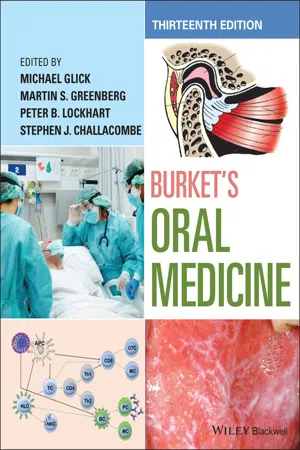
Burket's Oral Medicine
Michael Glick, Martin S. Greenberg, Peter B. Lockhart, Stephen J. Challacombe, Michael Glick, Martin S. Greenberg, Peter B. Lockhart, Stephen J. Challacombe
- English
- ePUB (mobile friendly)
- Available on iOS & Android
Burket's Oral Medicine
Michael Glick, Martin S. Greenberg, Peter B. Lockhart, Stephen J. Challacombe, Michael Glick, Martin S. Greenberg, Peter B. Lockhart, Stephen J. Challacombe
About This Book
This thoroughly revised Thirteenth Edition of Burket's Oral Medicine reflects the scope of modern Oral Medicine with updated content written by 80 contributing oral medicine and medical experts from across the globe.
The textemphasizes the diagnosis and management of diseases of the mouth and maxillofacial region as well as safe dental management for patients with complex medical disorders such as cardiovascular disease, cancer, infectious diseases, bleeding disorders, renal diseases, and many more.
In addition to comprehensively expanded chapters on oral mucosal diseases, including those on ulcers, blisters, red, white and pigmented lesions, readers will also find detailed discussions on:
- orofacial pain, temporomandibular disorders, headache and salivary gland disease;
- oral and oropharyngeal cancers, including the management of oral complications of cancer therapy;
- genetics, laboratory medicine and transplantation medicine;
- pediatric and geriatric oral medicine;
- psychiatry and psychology;
- clinical research; and
- interpreting the biomedical literature
The Thirteenth Edition of Burket's Oral Medicine is an authoritative reference valuable to students, residents, oral medicine specialists, teachers, and researchers as well as dental and medical specialists.
Frequently asked questions
Information
1
Introduction to Oral Medicine and Oral Diagnosis: Patient Evaluation
- INFORMATION GATHERING
- Medical History
- Patient Examination
- Consultations
- ESTABLISHING A DIFFERENTIAL AND FINAL DIAGNOSIS
- FORMULATING A PLAN OF ACTION
- Medical Risk Assessment
- Modification of Dental Care for Medically Complex Patients
- Monitoring and Evaluating Underlying Medical Conditions
- CLINICAL OUTCOMES AND ORAL DISEASE SEVERITY SCORING
- Oral Disease Severity Scoring
- Patient‐Reported Outcome Measures and Oral Mucosal Disease
- THE DENTAL AND MEDICAL RECORD
- Problem‐Oriented Record
- SOAP Note
- Confidentiality
- Informed Consent
- TELEHEALTH/TELEDENTISTRY
- History and examination.
- Establishing a differential diagnosis.
- Obtaining necessary consultations, as well as appropriate laboratory tests, such as specific blood investigations, a biopsy, and imaging studies, all based upon the initial differential diagnosis.
- Final diagnosis.
- Formulating a plan of action.
- Initiating treatment.
- Follow‐up assessment of response to treatment.
INFORMATION GATHERING
- Gathering the information necessary for establishing a diagnosis for the patient’s chief complaint.
- Assessing the influence of the patient’s systemic health on their oral health.
- Detecting other systemic health conditions of which the patient may not be aware.
- Providing a basis for determining whether dental treatment might impact the patient’s systemic health.
- Giving a basis for determining necessary modifications to routine dental care.
- Monitoring medical conditions of relevance to the maxillofacial condition.
Medical History
Table of contents
- Cover
- Table of Contents
- Title Page
- Copyright Page
- Dedication Page
- Preface
- List of Contributors
- 1 Introduction to Oral Medicine and Oral Diagnosis: Patient Evaluation
- 2 Overview of Clinical Research
- 3 Ulcerative, Vesicular, and Bullous Lesions
- 4 Red and White Lesions of the Oral Mucosa
- 5 Pigmented Lesions of the Oral Mucosa
- 6 Benign Lesions of the Oral Cavity and the Jaws
- 7 Head and Neck Cancer
- 8 Oral Complications of Nonsurgical Cancer Therapies
- 9 Salivary Gland Diseases
- 10 Temporomandibular Disorders
- 11 Neuropathic Orofacial Pain
- 12 Common Headache Disorders
- 13 Diseases of the Respiratory Tract
- 14 Diseases of the Cardiovascular System
- 15 Diseases of the Gastrointestinal Tract
- 16 Renal Diseases
- 17 Hematologic Diseases
- 18 Bleeding and Clotting Disorders
- 19 Immunologic Diseases
- 20 Transplantation Medicine
- 21 Infectious Diseases
- 22 Disorders of the Endocrine System and of Metabolism
- 23 Neurologic Diseases
- 24 Psychological and Psychiatric Aspects of Oral Health
- 25 Pediatric Oral Medicine
- 26 Geriatric Oral Medicine
- 27 The Role of Genetics in Oral Medicine
- 28 Laboratory Medicine and Diagnostic Pathology
- 29 How to Identify, Interpret and Apply the Scientific Literature to Practice
- Index
- End User License Agreement